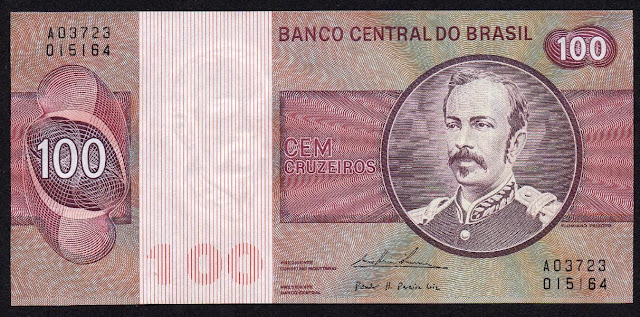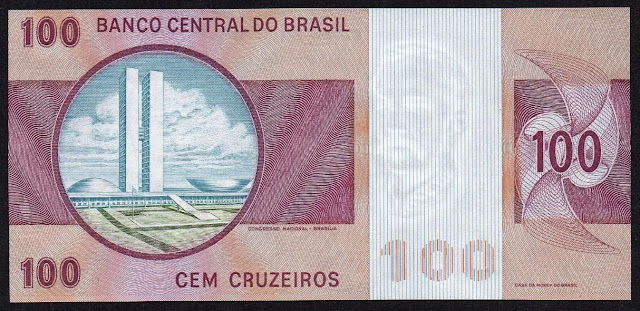Brazil Banknotes 100 Cruzeiros banknote 1975 Floriano Peixoto
Central Bank of Brazil - Banco Central do Brasil
Obverse: Portrait of Marshal Floriano Peixoto (1839 - 1895) Brazilian soldier and politician, a veteran of the Paraguayan War, 1st Vice-President of Brazil (1891) and the second president of Brazil (1891 – 1894). He is often referred to as "the Consolidator of the Republic" or "The Iron Marshal".
Reverse: The National Congress building in Brasilia designed by Oscar Niemeyer.
Watermark: Portrait of Marshal Floriano Peixoto.
Printer: Casa da Moeda do Brasil.
Dimensions: 167 x 78 mm.
Signatures: Presidente Conselho Monetário: Mário Henrique Simonsen.
Presidente do Banco Central do Brasil: Paulo Hortêncio Pereira Lira.
Brazilian Currency Banknotes - Brazil Paper Money
(1970-1981) "Cruzeiro" Issue
1 Cruzeiro 5 Cruzeiros 10 Cruzeiros 50 Cruzeiros 100 Cruzeiros
The National Congress building in Brasilia designed by Oscar Niemeyer
In early 1900s, the Brazilian National Congress happened to be in separate buildings. The Senate was located near Railway Central Station, beside the Republica Square, at Moncorvo Filho Street, where there is today a Federal University of Rio de Janeiro students' center. The Federal Chamber of Deputies was located at Misericórdia Street, which would later be the location of the State of Rio de Janeiro's local Chamber of Deputies. From the 1930s to early 1960s, the Senate occupied the Monroe Palace, which was demolished in the 1970s to allow the construction of the subway Cinelândia station. The Federal Chamber of Deputies moved to Brasília in early 1960s as well, but for a couple of years temporarily occupied a building near the Municipal Theater.
Since the 1960s, the National Congress has been located in Brasília. As with most of the city's government buildings, the National Congress building was designed by Oscar Niemeyer in the modern Brazilian style.
The semi-sphere on the left is the seat of the Senate, and the semi-sphere on the right is the seat of the Chamber of the Deputies. Between them are two vertical office towers. The Congress also occupies other surrounding office buildings, some of them interconnected by a tunnel.
The building is located in the middle of the Monumental Axis, main street of Brasília. In front of it there is a large lawn where demonstrations take place. At the back of it, is the Praça dos Três Poderes, where lies the Palácio do Planalto and the Supremo Tribunal Federal.
On December 6, 2007, the Institute of Historic and Artistic National Heritage (Portuguese: Instituto do Patrimônio Histórico e Artístico Nacional) decided to declare the building of the National Congress a historical heritage of the Brazilian people. The building is also among the UNESCO World Heritage Sites, as part of Brasília's original urban buildings, since 1987.

